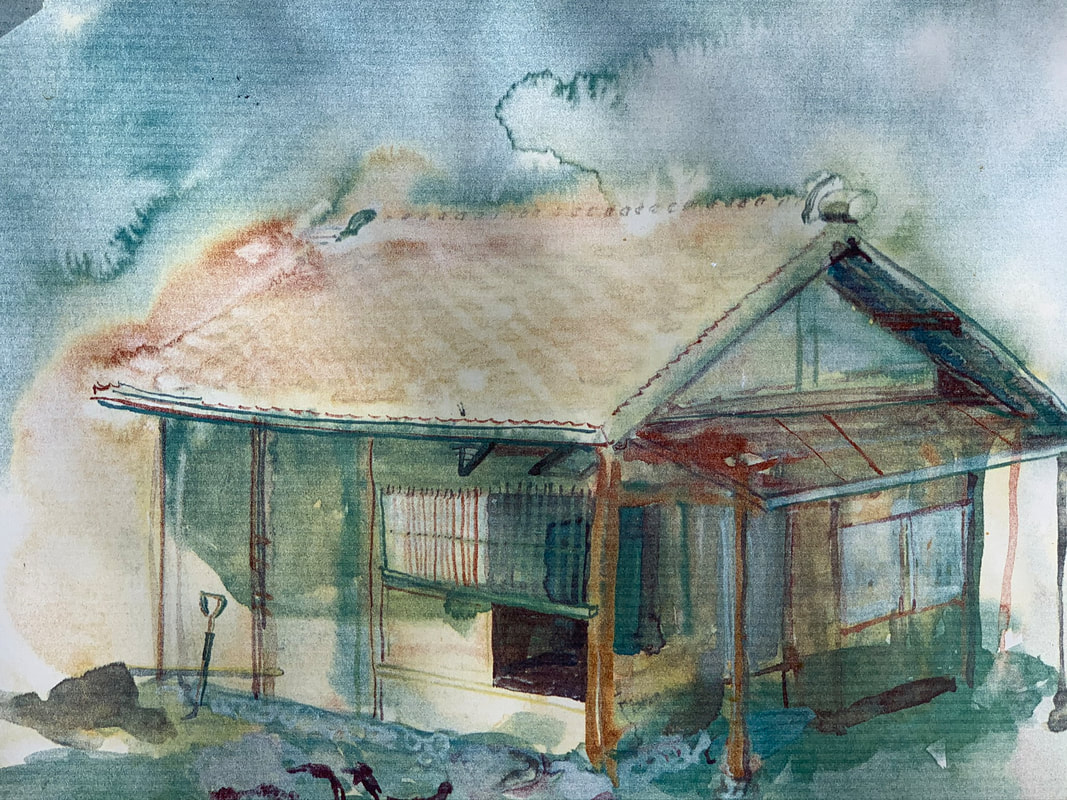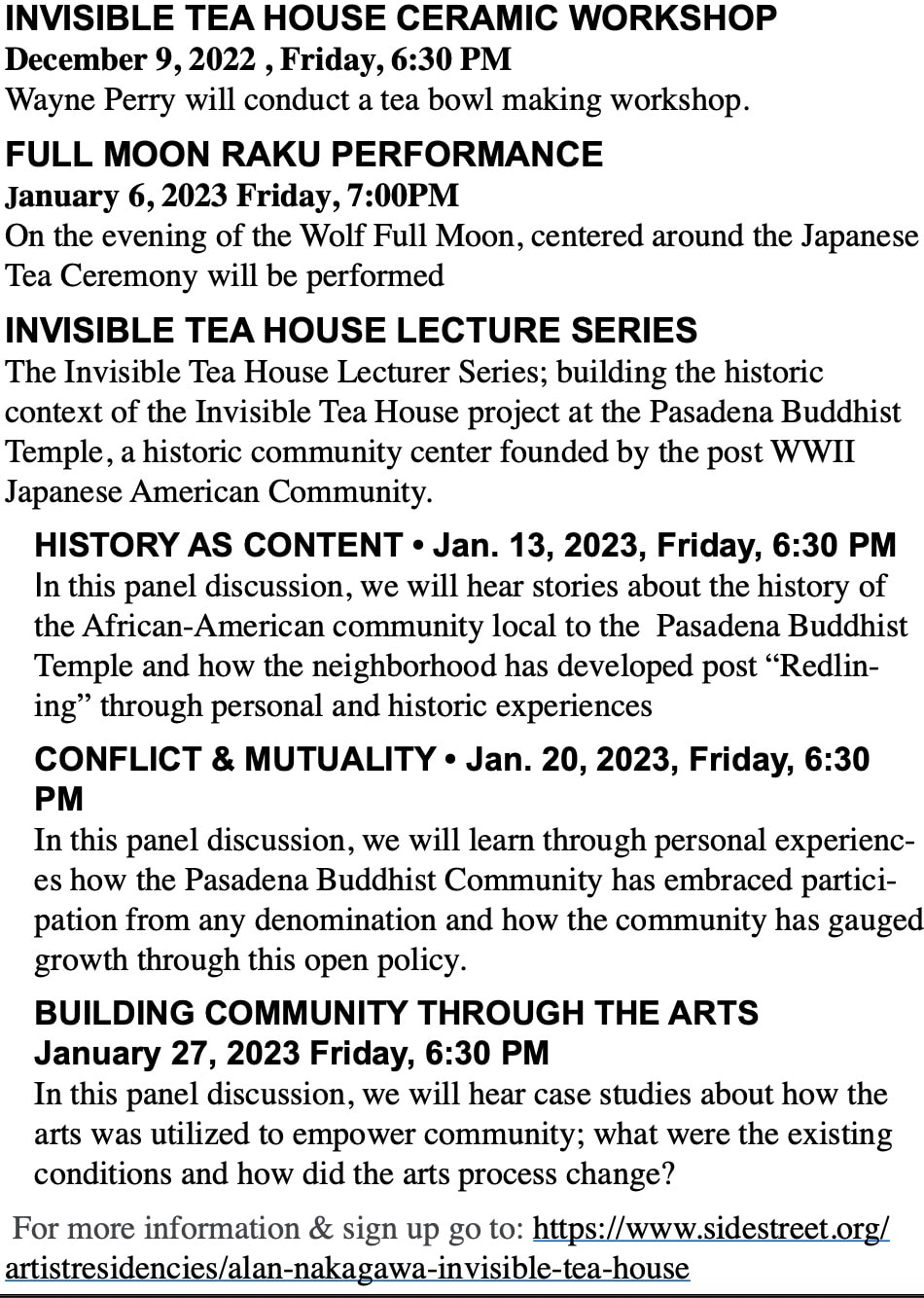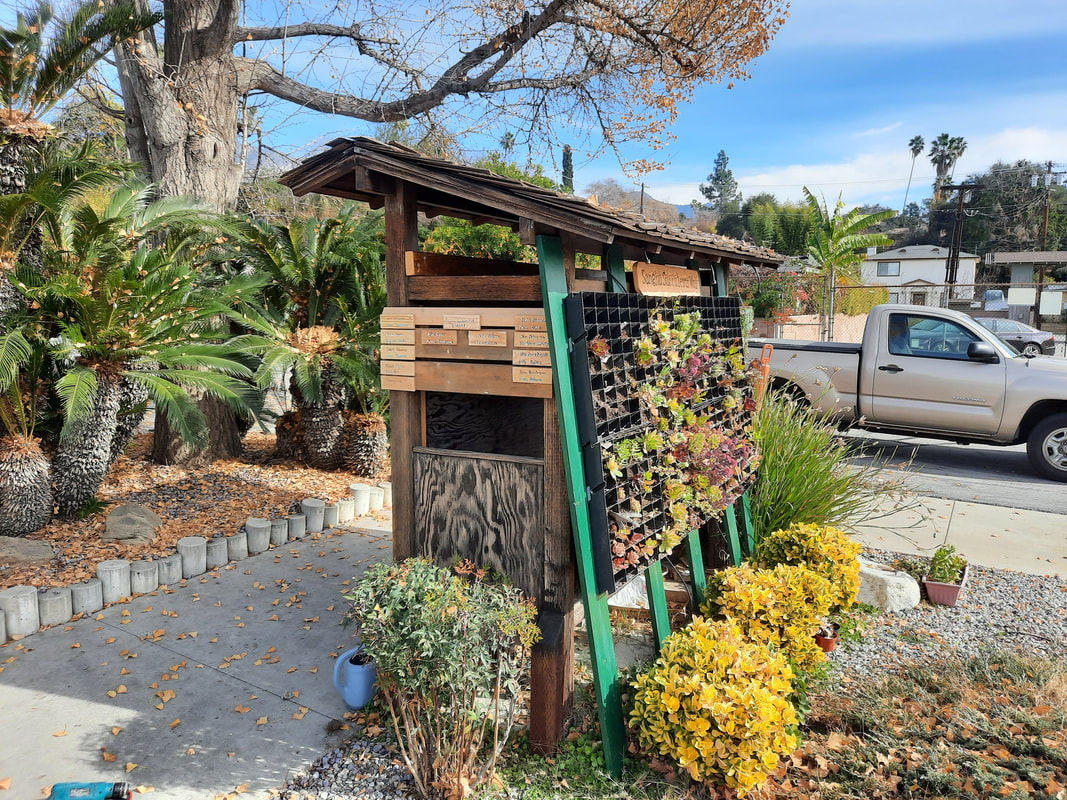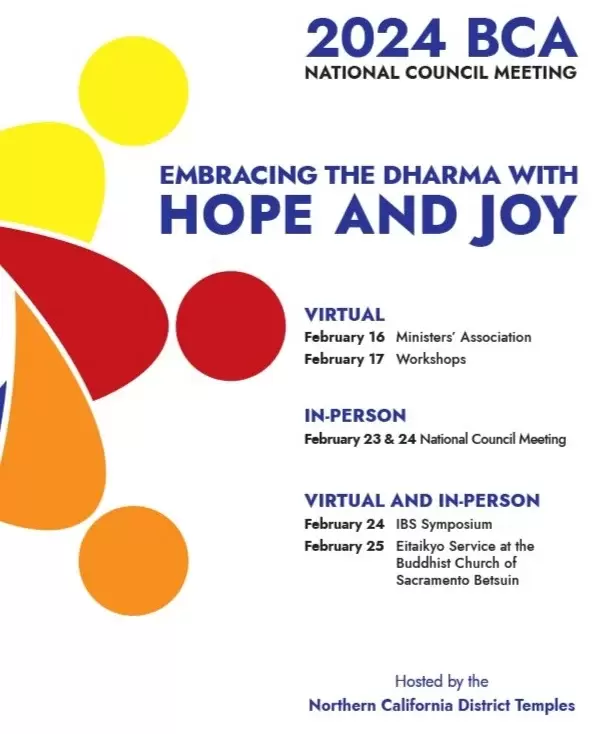#Invisible Tea House
|
The Pasadena Buddhist Temple has been the beneficiary of the efforts by our Artist-in-Resident, Alan Hiroshi Nakagawa.
PHASE THREE - DECEMBER 2022 to MARCH 2023

PHASE ONE, during 2019-2020. Mr. Nakagawa became intrigued by the sign in the temple garden describing a tea house that was no longer present, "Seifu-An" having been donated to the Huntington Library in 2011. During the course of his residency, Mr. Nakagawa has produced a multi-media history and artifacts to help preserve the memory of the efforts of the temple community to house and maintain the tea house for 40 years. A project description is included below, as well as a photo gallery/archive, podcast of interviews to preserve memories and thoughts on the history and role of the teahouse at the temple, as well as art works produced by Mr. Nakagawa and local artisans to provide the temple with a portable tea ceremony table, equipment and sign so that the #InvisibleTeahouse will never be forgotten. His presence at our temple was made possible through Side Street Projects, Pasadena Art Alliance and the California Arts Council. PHASE TWO 2020-2021. Mr. Nakagawa will conduct research into the Temple archives regarding the use of the Japanese Language and when that use became less dominate.. 1) OTTO = SOUND : BANASHI = STORY O=S:B=S will be an original series of sound-based multi-media performances by Alan Nakagawa about Japanese American cultural preservation and language post WWII with input from members of the Pasadena Japanese American Community with histories at the Pasadena Buddhist Temple. O=S:B=S will be a site-specific sound-based inter-disciplinary performance about the role of the Japanese language based on data collected through research by the Artist including the history of Japanese typesetting machines recently found in storage underneath the Temple. The history of these machines is directly tied into the vibrant Japanese American Culture that once thrived in the City and is an artifact that marks the change from a predominately Japanese speaking community to an predominately English speaking community. The research of existing archives, community member interviews and artifacts in storage at the Temple, will be the elements the Artist will use to create a series of tone poems that will be multi-media but also be edited for the internet. The Temple was built by families who returned to Pasadena after having been imprisoned in the Japanese Concentration Camps during WWII. OTTO: SOUND/ BANASHI: STORY is made possible through a grant from the City of Pasadena Cultural Affairs Department. The final presentation will be scheduled in the early Summer of 2021. 2) SANGHA SUCCULENTS WALL: a participatory project re-purposing the Machiai formerly built for the tea house by Sam Sakahara. Members and community were asked to donate a succulent, Side Street Project provided the plant wall framework and the S.O.G.s supported the retrofit and irrigation. Along with the wall of succulents, Nakagawa adorned the structure with information regarding the Machia and project donors. 3) TSUGU VIDEO: Inspired by the repairing of asphalt cracks in the large parking lot of the Temple by the S.O.G.s, Nakagawa developed a short video linking the massive "drawing" to tattoo art and the Japanese art of ceramic repair, Kintsugi. link Invisible Teahouse Sign and Art
|
Mr. Nakagawa recorded a series of interviews with Temple members and persons with insights into the history and significance of the teahouse:
#2 Keiji Uesugi #3 Mark Oune #4 Robert Fukumoto #5 Jose Salcedo #6 Emily Hopkins #7 Rev. Gregory Gibbs #8 Jeannie Toshima #9 Kathy Kumagai Click on individual names or the button to see the entire podcast series. "Updated: A Tale of Pasadena, a Japanese Tea House, and the Way of Tea", by Kent Matsuoka
Tea ceremony teacher, Jose Salcedo, narrates a slide show of some of the photo archive created by Mr. Nakagawa from the Pasadena community and the Sakahara Estate.
Mr. Nakagawa created the soundscape to a video of Mr. Salcedo performing the tea ceremony as part of the Pasadena Art Night at the Pasadena Buddhist Temple.
|
PHASE ONE: INVISIBLE TEAHOUSE PROJECT OVERVIEW
Design | Photography | Photos
Interdisciplinary-artist Alan Nakagawa was invited to become the artist-in-resident of the Temple through the support of Side Street Projects, a local arts organization who secured funding from the Pasadena Art Alliance and the California Arts Council.
During the 2018 Obon, Nakagawa was given a tour of the campus and was drawn to a sign in the Japanese Garden in back of the Temple, a hand painted wood sign that documents the donation of a tea house in 1964. The tea house had been re-installed at the Huntington Library and Gardens in 2011.
PHASE TWO (TBD)
We are currently writing grants, proposing a three year extension of Alan's residency titled "Invisible Tea House Artist Museum". Our intention is to expand the multi-media; research-art activation process to other facets of historic artifacts at the Temple. More in the future to celebrate the history of this unique post WWII Japanese American legacy and how the community culturally survived through an artist interpretive community-based archive program.
PHASE ONE (March 2019 - March 2020)
Alan Nakagawa started his research and soon found himself visiting the Temple on a regular basis, meeting the Sons of Gardeners (SOGs), Jose Salcedo Sensei and other volunteers. Some of these interactions resulted in a podcast series of the same name, Invisible Tea House available on SoundCloud (see link above).
"Updated: A Tale of Pasadena, a Japanese Tea House, and the Way of Tea", Kent Matsuoka, July 10, 2019, ColoradoBoulevard.net: link
As of March 2020, here are the components of the project:
1. The Invisible Tea House, we have a hashtag #invisbleteahouse , (check it out on IG)
- Alan Nakagawa spent one year as the artist-in-resident at the Pasadena Buddhist Temple with a focus on the Japanese Tea House that once was there but is now at the Huntington Library and Gardens in San Marino. With support from local arts organization Side Street Project which secured funds from the Pasadena Art Alliance, Nakagawa weaved an inter-disciplinary portrait of history and ethnic-identity through the generosity of the Temple community.
- Launched the PBT Photography Archive Project; We knew the Temple members and the greater community would have photos pertaining to the history of the tea house. A call was advertised for images and a campaign to collect pictures was launched at the 2019 PBT OBON. Side Street Project staff was at hand for the two day festival to digitize these images for the Temples archive. They supplied the computer, scanners and staff. Special shout out to the Armory Center for the Arts for their support with the scanner.
- Ninomiya Pop Up: Paralleling the Invisible Tea House project was another art project by Nakagawa at CalState University Dominguez Hills. He had spent eighteen months researching the archives of the Ninomiya Photo Studio, once located in Little Tokyo. An exhibition of Nakagawa's art responses were on display for six months at the University Gallery and a POP UP related to the exhibition was on display at the 2019 PBT OBON. The Ninomiya POP UP was a make-believe photo studio made up of a large format camera, back drop and information on the historic studio. Obon participants were encouraged to take a selfie. If they posted it with the hashtag, #unfinishedproofninomiya , they received a limited edition zine from the exhibition. Deema Aljibeh, CSUDH, solicited CSUDH staff and students to volunteer for the two-day OBON for the Ninomiya Pop Up.
- Tea Ceremony: In the past, the late Sakahara Sensei would give tea ceremony demonstrations at the OBON. This had not happened for six years. We asked Jose Salcedo Sensei, who has continued Sakahara Sensei's practice, to resurrect this tradition at the OBON. Obon visitors watched a demonstration and then were invited to have some tea. Thank you to Salcedo Sensei and the practitioners of Urasenke Tea Ceremony for their participation and support.
- Invisible Tea House Podcasts link . At first, Alan thought he was interviewing temple members about the tea house but it's become much broader than that. The podcasts have collectively become an essay on post-WWII Japanese-American identity and first hand accounts of cultural survival.
- The Pasadena Art Night; October 11, 2019/ 6-10 PM (The Temple's first participation in the annual City event)
- Jose Salcedo oral history; We asked Jose Salcedo Sensei to narrate the images and share anecdotes. This interview was recorded by filmmaker Wengsan San Sit and this will become part of the Temple archive. It is currently available on Vimeo: link
- Alan Nakagawa presented his sound art, "Conical Sound: Simon Rodia/Anotni Gaudi" link
- A short film about Salcedo Sensei's Ikebana philosophy by Christo Mercado was screened
- There was a multi-media presentation of select images from Sakahara Sensei's Archive of the various Tea Ceremony events and the Tea House throughout the decades at Pasadena Buddhist Temple. These images were projected onto the Temple's exterior walls and in the garden where the tea house once stood. Michi Oba, Sensei's Daughter, gave Alan permission to digitize their entire photo archive, over 300 images.
- We solicited artwork from Temple members who practice art and those works were exhibited inside the Temple. Artist Michael Rippens curated and produced the presentation.
- Alan made a video art work with Salcedo Sensei featuring Sensei practicing the Tea Ceremony at the Sakahara Estate Tea House: link
- Lastly, the annual PBT Fall Dinner took place at the same time. Delicious dinners, desserts and drinks were for sale to visitors.
- Temple Member Artist Exhibition; After the Pasadena Art Night, donated artworks by Temple members were curated into an exhibition in the hallway
3. Invisible Tea House: Misonodana Time Machine; 2020, February 16, 2020 @ 10AM, Inauguration of this three part art project.
- To conclude this inaugural year of Nakagawa's residency, a series of works were created in response to the research regarding the tea house. This resulted in the following works:
- Lotus Sign: Nakagawa designed and fabricated a lotus leaf inspired sign that includes porcelain enamel reproductions of watercolors he painted of Sakahara Sensei, the tea house and the Temple members who originally assembled the tea house in 1964. The wood used for this artwork is of a Lebanese Cedar that fell in recent years in Alta Dena and is part of the family of cedars that also make up Christmas Tree Lane.
- Misonodana: Side Street Projects Max Geldman designed and fabricated an original Misonodana which now sits inside the Temple and is used for tea ceremony demonstrations. The wood used for this artwork is of a Lebanese Cedar that fell in recent years in Alta Dena and is part of the family of cedars that also make up Christmas Tree Lane.
- Tea Set: Working with ceramicist Wayne Perry, Nakagawa created a series of three ceramic tea bowls and a unique case. Each tea bowl has a drawing of the nose of tea ceremony instructors Matsumoto Sensei, Sakahara Sensei and Salcedo Sensei.
Your browser does not support viewing this document. Click here to download the document.




